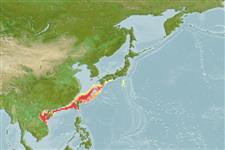Myxini (slijmprikken) (hagfishes) >
Myxiniformes (Hagfishes) >
Myxinidae (Hagfishes) > Eptatretinae
Etymology: Eptatretus: hepta (Gr.), seven; tretos (Gr.), perforated (i.e., with holes), referring to seven gill apertures on what would later be described as Homea banksii (=E. cirrhatus) [range within genus is 6-14 pairs of gill apertures] (See ETYFish); nelsoni: In honor of ichthyologist Gareth J. Nelson (b. 1937), then with the American Museum of Natural History, for contributions to the promotion of phylogenetic systematics (See ETYFish).
Eponymy: Dr Gareth (Gary) Jon Nelson (d: 1937) is Emeritus Curator Vertebrate Zoology, Ichthyology, at the AMNH where he worked for over three decades (1967–1998), having been chairman of ichthyology (1982–1987) and of ichthyology and herpetology (1987–1993) [...] (Ref. 128868), visit book page.
Environment: milieu / climate zone / depth range / distribution range
Ecologie
marien demersaal; standvastig; diepte 50 - 250 m (Ref. 51420). Subtropical
Northwest Pacific: southwest Taiwan.
Lengte bij maturiteit / Grootte / Gewicht / Leeftijd
Maturity: Lm 24.0, range 22 - 26 cm
Max length : 25.9 cm TL mannelijk / geslacht onbekend; (Ref. 51420)
Gill apertures usually 5 (4-6). Slime pores: prebranchial 14-20; branchial 0; trunk 35-39; tail 6-10; total 57-67. Gill apertures nonlinear and crowded.
A dwarf species; males develop testes at about 20 cm and a 22.4 cm female had elongated eggs; a 26.8 cm specimen had eggs 2.4 cm long; and a 24.4 cm specimen had 11 eggs about 1.5 cm long with polar caps already forming (Ref. 51420).
Levenscyclus en paargedrag
Maturiteit | Voortplanting | Paaien | Eieren | Fecunditeit | Larven
Copulatory organ absent. The gonads of hagfishes are situated in the peritoneal cavity. The ovary is found in the anterior portion of the gonad, and the testis is found in the posterior part. The animal becomes female if the cranial part of the gonad develops or male if the caudal part undergoes differentiation. If none develops, then the animal becomes sterile. If both anterior and posterior parts develop, then the animal becomes a functional hermaphrodite. However, hermaphroditism being characterised as functional needs to be validated by more reproduction studies (Ref. 51361 ).
Fernholm, B., 1998. Hagfish systematics. p. 33-44. In J.M. Jørgensen, J.P. Lomholt, R.E. Weber and H. Malte (eds.) The biology of hagfishes. Chapman & Hall, London. 578 p. (Ref. 31276)
Status op de Rode Lijst van het IUCN (Ref. 130435: Version 2024-1)
Gevaar voor de mens
Harmless
Gebruik door de mens
Visserij: van geen belang
Tools
Speciale rapporten
Download XML
Internetbronnen
Estimates based on models
Fylogenetische diversiteitsindex (Ref.
82804): PD
50 = 0.5000 [Uniqueness, from 0.5 = low to 2.0 = high].
Bayesian length-weight: a=0.00204 (0.00094 - 0.00444), b=2.93 (2.74 - 3.12), in cm total length, based on LWR estimates for this (Sub)family-body shape (Ref.
93245).
Trofisch niveau (Ref.
69278): 3.9 ±0.7 se; based on size and trophs of closest relatives
Weerstandsvermogen (Ref.
120179): laag, minimale populatieverdubbelingstijd 4,5-14 jaar (Fec assumed to be <100).
Fishing Vulnerability (Ref.
59153): Low vulnerability (16 of 100).
